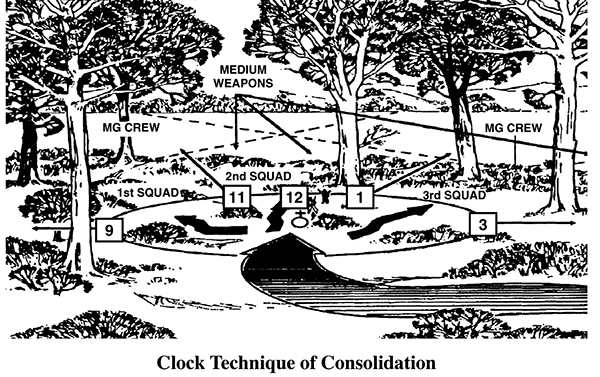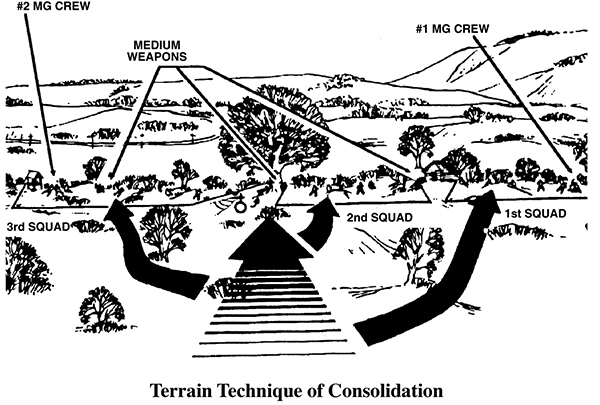Movement to the Objective
The attacking force advances to within assault distance of the enemy position under supporting fires, using a combination of traveling, traveling overwatch, and/or bounding overwatch. Platoons advance to successive positions using available cover and concealment. The company commander may designate SBF positions to protect friendly forces with suppressive direct fires. As the company maneuvers in zone, it employs fires to suppress, neutralize, and obscure the enemy positions.
Assembly Area to the Objective Rally Point. The ORP is where elements of the assault force transition to secure movement techniques in preparation for contact with the enemy. Platoons may maneuver from the ORP to designated SBF positions, assault positions, or breach or bypass sites. Before leaving the AA, the platoon leader should receive an update of the location of forward and adjacent friendly elements. He should also receive updated enemy locations. The platoon moves forward from the AA to the ORP, usually as part of a company formation, along a planned route. The platoon leader should have reconnoitered the route to the ORP (with either a map, scouts, or aircraft).
Objective Rally Point to Assault Position. The platoon’s assault element moves from the ORP to the assault position. If necessary, the platoon leader plots waypoints to coincide with checkpoints along the route. During movement, he ensures the platoon navigates from checkpoint to checkpoint or phase line by using basic land navigation skills supplemented with precision navigation.
Assault Position to the Objective. The assault position is the last covered and concealed (LCC) position before reaching the objective. Ideally, the platoon’s assault element occupies the assault position without the enemy detecting any of the platoon’s elements. Preparations in the assault position may include preparing Bangalores, other breaching equipment, or demolitions; fixing bayonets; lifting or shifting fires; or preparing smoke pots. The platoon may halt in the assault position if necessary to ensure synchronization of friendly forces. Once the assault element moves forward of the assault position, the assault must continue.
Supporting fire from the heavy weapons must continue to suppress the enemy and must be closely controlled to prevent fratricide.
When the assault element moves to the breach point, the base-of-fire leader verifies the assault element is at the right location. The base-of-fire leader is responsible for tracking the assault element as it assaults the objective. The company commander shifts or lifts indirect fire when it endangers the advancing soldiers and coordinates this with the platoons’ assaults. As the fire of the platoons’ support is masked, the platoon leader shifts or lifts it or displaces the weapons squad to a position where continuous fire can be maintained.
Isolate the Objective
The goals of isolation are to prevent the enemy from reinforcing the objective and to prevent enemy forces on the objective from leaving. Infantry platoons will likely be an isolating force within a company.
Actions on the Objective: Seize a Foothold and Exploit the Penetration
The platoon leader often designates assault, support, and breach elements within his platoon to conduct a deliberate attack. One technique is to designate the machine-gun teams (or weapons squad) as the support element, an infantry squad as the breach element, and the remaining platoon as the assault element. The supporting elements support the breach element’s initial breach with suppressive fires; as the breach is being established, the support element should shift fires to allow the breach element to penetrate the objective and to avoid committing fratricide. The support element positions itself to provide continual close-in suppressive fire to aid the actions of the assault squad (or squads) as it moves across the objective. Once the breach element has seized the initial foothold on the objective, the assault element may then move through the breach lane to assault the objective. All communication from the support element to the breach, assault, and weapons squads is by FM radio or signals. Problems and status updates are continuously communicated or observed, and changes are made as necessary.
Consolidation and Reorganization
Once enemy resistance on the objective has ceased, the platoon must quickly take steps to consolidate and prepare to defend against a counterattack. There are two main consolidation techniques:
Clock Technique. In this method, the platoon leader designates either a compass direction or the direction of attack as 12 o’clock. He then uses clock positions to identify the left and right boundaries for squads. The platoon leader positions key weapons along the most likely avenue of approach based on his assessment of the terrain.
Terrain Feature Technique. In a similar manner, the platoon leader identifies obvious terrain features as the left and right limits for squads. Terrain can also be used to identify where defensive positions can be established.
In both techniques, the platoon leader ensures that squad sectors of fire overlap each other and provide mutual support for adjacent units.
Once platoons have consolidated on the objective, they begin to reorganize to continue the attack. Reorganization involves:
•Reestablishing command and control.
•Re-manning key weapons and redistributing ammunition and equipment.
•Clearing the objective of casualties and EPWs.
•Assessing and reporting the platoon status of personnel, ammunition, supplies, and essential equipment (ACE report to higher).


HASTY ATTACK
Platoons and squads normally participate in a hasty attack as part of a larger unit, during an MTC, as part of a defense, or whenever the commander determines that the enemy is in a vulnerable position and can be quickly defeated by immediate offensive action. Hasty attacks are used to exploit a tactical opportunity, maintain the momentum, regain the initiative, prevent the enemy from regaining organization or balance, and gain a favorable position that may be lost with time. Because its primary purpose is to maintain momentum or take advantage of the enemy situation, the hasty attack is normally conducted with only the resources that are immediately available. The key to hasty attacks is maintaining unrelenting pressure on the enemy and attacking before the enemy can act. Synchronization in the hasty attack can be degraded a bit, so commanders should minimize risk by maximizing the use of standard formations, SOPs, and well-rehearsed, thoroughly understood battle drills. The hasty attack is often the preferred option during continuous operations and frequently results from an MTC, successful defense, or continuation of a previous attack.
Task Organization
The hasty attack is conducted using the principles of fire and movement. The controlling headquarters normally designates a base-of-fire force and a maneuver force.
Conduct of the Hasty Attack
The platoon must first conduct actions on contact, allowing the commander to gather the information he needs to make an informed decision. The term “hasty” refers to limits on planning and preparation time, not to any acceleration in the conduct of actions on contact. Because the intelligence picture is vague, the commander normally needs more time, rather than less, during this process to gain adequate information about the enemy force.
Execution begins with the establishment of a base of fire, which then suppresses the enemy force. The maneuver force uses a combination of tactical techniques and combat multipliers (such as indirect fire) to maintain its security as it advances in contact to a position of advantage. Understanding the geometry of the battlefield is key to successful attacks by allowing the infantry commander to effectively occupy and take advantage of superior positions.